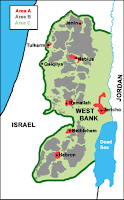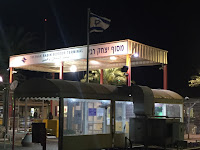
We had a great time on our
Middle East adventure last week.
Eilat was the perfect place for some quiet beach time. Especially last week when a cold blast of snow and freezing wind set record low temperatures across Europe.

Thanks to the Sibiřská zima,
Siberian cold, Brno was -14℃ (7℉). I definitely felt friends freezing back home while it was 28℃ (82℉) on the beach.

On Monday we went to
Egypt and visited
Saint Catherine's Monastery.

Egypt has long been a popular beach holiday destination for Czechs. The number of tourists declined after the revolution in 2011 but have steadily increased the last couple of years.

On Wednesday we took our long day trip to
Jerusalem and the Dead Sea.
I can definitely see going back to spend some more time at the Dead Sea. Quite the experience.

Then we went in to
Palestine to visit the
Church of the Nativity in Bethlehem.

Something I didn't understand was that the Oslo II Accord actually divided up the West Bank into three different areas. Area A is where the Palestinian Authority has administrative control, Area B is co-administered with
Israel, and Area C contains settlements only controlled by Israel.

Israelis are not allowed to enter Area A. This sign warns that it is both dangerous and against the law for Israeli citizens to enter Area A.

On Friday we took our tour to
Petra. It was even better than I thought it would be. The carvings were so cool. I wish we had more time to really explore Petra but we hit the major highlights. I'm glad that we didn't stay over though because
Jordan is ridiculously expensive.

Since 2013, Israel no longer stamps your passport. Instead you receive a paper ticket every time you enter or exit the country which you hold on to. There are several counties which won't let you enter if there's any evidence in your passport that you've been to Israel.
The thing is that Egypt and Jordan do stamp your passport. So there's now evidence in my passport that I used the Taba border crossing in Egypt, and since the only country that one can get to from here is Israel, which means it's pretty easy to figure out where I've been.
 |
| Israeli border crossing to Jordan |
It's the same story with the Jordanian border crossing. My passport now won't let me enter Iran, Iraq, Kuwait, Lebanon, Libya, Pakistan, Saudi Arabia, Sudan, Syria, or Yemen.
 |
| Aqaba, Jordan, across the Red Sea |
While not immediate travel destinations I would like to eventually go to Iran and Lebanon. I'll either have to get a second U.S. passport, which will only be valid for two years, but won't show evidence of having been in Israel. Or I wait until I eventually get a Czech passport.

The rest of the time we just relaxed on the beach and enjoyed our time in Eilat.
 |
| Mall security |
Mall security is no joke in Israel. According to the law, you can enter only a shopping centre after clearing security. Your bags will be searched and you go through a metal detector. It's quick and easy and you don't have to remove your shoes like at an airport.
The biggest surprise actually came when we left. Ryanair says to be at the airport at least two hours before your flight. However, Israeli airport regulations state that passengers should arrive at least three hours prior to your flight in order to clear security. It took us about 2,5 hours to make it to the gate.
First you get in line to talk to a security who asks a few questions and looks through your passport.
I think there's a bit of racial profiling that goes on as well. We were then split up and asked the same questions again separately. It didn't seem to be a problem that we had gone to Egypt or Jordan but security had lots of questions about out visit to
Morocco a year ago. Why did I go to Morocco? Do I know anyone there? What did I do? Did I meet anyone there? It took a while to explain that it was just
a day trip and again, a year ago.
 |
| "2" is low risk but "6" is the highest risk |
After about five minutes they put a yellow sticker on my passport and I could then get in the queue for baggage inspection. All of your bags go through a screening machine. Some people were told to remove iPads but I wasn't so I left it in the bag. Depending on the number on the yellow passport sticker, some people had to then go to another bag check where they had open their bags and watch an official inspect every item.
I'm glad that this didn't happen to me. Then you go to the airline counter and check in your bag. After this you then go through "normal airport security" where you remove your liquids from your carry-on, take off your shoes and pass through metal detectors. Then you go to passport control and then finally you are cleared to go to the gate. Super thorough but you can definitely feel safe at an Israeli airport.



 In the USA, the two slang terms for money that were most popular when I grew up were bucks and clams. I'm sure that there are plenty of others. The names for American coins are as follows. A quarter is 25 cents. A dime is 10 cents. A nickel is 5 cents and a penny is 1 cent.
In the USA, the two slang terms for money that were most popular when I grew up were bucks and clams. I'm sure that there are plenty of others. The names for American coins are as follows. A quarter is 25 cents. A dime is 10 cents. A nickel is 5 cents and a penny is 1 cent. A 100 dollar bill is often called a C-note because "C" is the Roman numeral for 100. It's also called a "Benjamin" because Benjamin Franklin is on the $100 bill.
A 100 dollar bill is often called a C-note because "C" is the Roman numeral for 100. It's also called a "Benjamin" because Benjamin Franklin is on the $100 bill. In the UK, cash spending money is called dosh. Pounds are called quid. A £5 bank note is a fiver and a £10 note is a tenner.
In the UK, cash spending money is called dosh. Pounds are called quid. A £5 bank note is a fiver and a £10 note is a tenner.



































